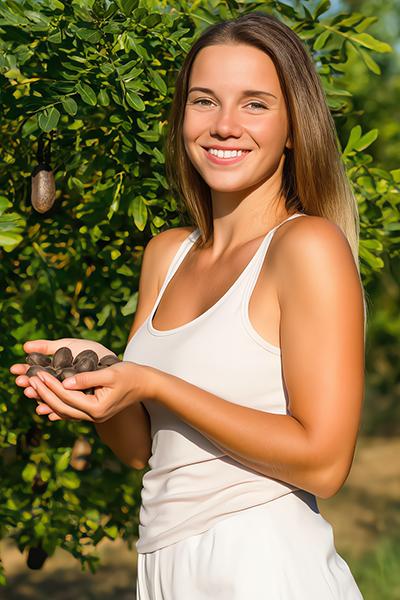No products in the cart.: $0.00
Shea Butter

Shea butter oil is a liquid oil derived from shea butter, which is extracted from the nuts of the shea tree (Vitellaria paradoxa), primarily found in West and East Africa. The oil is typically refined or fractionated from solid shea butter to create a lighter, more fluid consistency, making it easier to apply to skin and hair. It retains many of the nourishing properties of shea butter but is less heavy.
What is it Made of?
Shea butter oil is made by processing shea butter, which comes from cold-pressing or boiling shea nuts. The oil is extracted through fractionation (separating the liquid oil from solid fats) or further refining. Its key components include:
-
- Fatty Acids: Oleic acid (omega-9, hydrating), stearic acid (moisturizing), and linoleic acid (omega-6, supports skin barrier).
- Vitamins: Vitamin E (antioxidant, protects against free radicals) and Vitamin A (promotes skin repair).
- Triterpenes: Anti-inflammatory compounds that soothe skin and aid healing.
- Phenolic Compounds: Provide antioxidant and antimicrobial properties.
- Sterols: Support skin elasticity and repair.
Best Skin Type for Using It:
Shea butter oil is versatile but works best for:
-
- Normal Skin: Can be used but might be overly rich for daily use.
- Dry or dehydrated Skin: Excellent, its rich emollient properties deeply moisturize and prevent water loss.
- Oily Skin: Use with caution; opt for whipped or refined shea butter to avoid excess oiliness.
- Combination Skin: Good for dry areas but must be used sparingly on oilier parts.
- Sensitive Skin: Generally well-tolerated, especially if unrefined, due to its soothing properties. However, always do a patch test.
- Mature Skin: Nourishes and improves elasticity, reducing the appearance of fine lines.
-
Avoid:
- Not ideal for: Acne-prone or very oily skin, as it can be comedogenic (pore-clogging) for some, especially if overapplied or if the oil is highly refined
Benefits of Shea Butter
-
- Deep Moisturization: Shea butter is renowned for its deep moisturizing properties due to its high content of fatty acids like linoleic, oleic, palmitic, and stearic acids. It helps in hydrating the skin by creating a protective barrier that locks in moisture.
- Skin Repair: Contains vitamins A and E, which aid in healing and improving skin conditions like eczema and dermatitis.
- Anti-inflammatory and Healing: It possesses anti-inflammatory properties that can soothe various skin conditions such as eczema, dermatitis, and psoriasis. Shea butter also aids in wound healing and reduces skin inflammation.
- Antioxidant Properties: Rich in vitamins A and E, shea butter offers antioxidant benefits that can combat skin aging by protecting against free radicals, thus helping to maintain youthful skin.
- Skin Elasticity: Its emollient nature helps in enhancing skin elasticity, reducing the appearance of wrinkles and stretch marks.
- Skin Repair: Contains vitamins A and E, which aid in healing and improving skin conditions like eczema and dermatitis.
Pros and Cons of Green Tea Extract
Pros:
-
- Versatile Application: Suitable for use on face, body, hair, and even lips. Can be incorporated into various cosmetic products.
- Non-Comedogenic: When in its pure form, it’s often considered non-comedogenic, although this can vary by individual skin type.
- Natural and Safe: Generally well-tolerated by the skin, with very low risk of allergic reactions, even among those allergic to tree nuts.
Cons:
-
- Texture and Absorption: Shea butter can be thick and might not absorb quickly into the skin, potentially leaving a greasy residue. This might not be ideal for daytime use or under makeup.
- Potential for Acne: Although often labeled as non-comedogenic, for some with acne-prone skin, shea butter might clog pores, leading to breakouts.
- Quality Variability: The benefits decrease with more processing; refined shea butter might lose up to 75% of its bioactive nutrients.
Infusing shea butter with botanicals can enhance its healing and therapeutic properties, making it even more beneficial for skin care. Remember to always do a patch test, especially when introducing new herbs, to check for skin compatibility.



